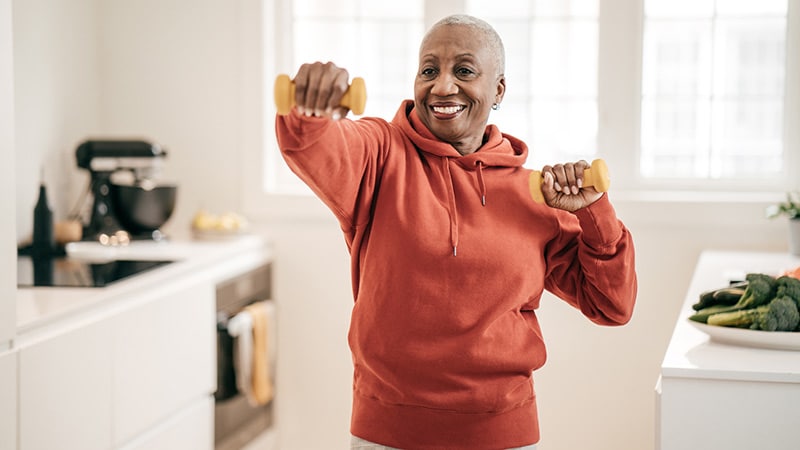Physical activity at home helps reduce cancer-related fatigue
Low to moderate physical activity at home may reduce fatigue in cancer survivors who have completed treatment, the authors of a new meta-analysis conclude.
Fatigue is reported by about 40% of cancer survivors, and symptoms can persist for up to 10 years after cancer diagnosis, they note.
The meta-analysis included 11 studies and 1066 cancer survivors, mostly women with a history of breast cancer.
Results show that physical activity at home improves fatigue for up to 9 months after the intervention, especially when accompanied by frequent counseling, reports Famke Huizinga, MSc, University Medical Center Groningen, Groningen, The Netherlands , and his colleagues.
The research, published in the December issue of Medicine and science in sport and exercisealso found that adherence to the intervention was high and self-reported physical activity increased over time.
“We conclude that home-based physical activity interventions with frequent counseling provide an appropriate and effective intervention for relieving fatigue in cancer survivors,” the authors write.
Approached for comment, Nigel Brockton, PhD, vice president of research at the American Institute for Cancer Research, said the effect of physical activity on fatigue and quality of life in cancer survivors has already been reported, and he also noted that the studies included in this meta-analysis “were all quite small.”
Nevertheless, Brockton said Medscape Medical News that it is “encouraging” that the association was replicated in the meta-analysis and found a high level of compliance with the intervention. “It’s not what we’ve seen in so many other physical interventions.”
He also noted that the effect of home physical activity was “stronger” than previously observed, indicating that there is “great potential to improve patient outcomes”.
Brockton stressed that the importance of interventions such as physical activity at home is that it gives “the feeling that you have some control over your destiny after being released, if you wish, by the medical system.
“Physical activity is such a fundamental behavior that it tends to have effects on other aspects of life,” he added, such as encouraging people to, for example, “eat better.”
Brockton continued that frequent counseling and monitoring “is much more feasible” through online programs, which have become more acceptable during the COVID-19 pandemic, not only because survivors are more comfortable with these tools. , but also that institutions become more open to their use.
Indeed, “some of the ethical barriers” have been removed, he explained.
“Before pretty much anything going online, ethics committees were reluctant to approve projects” that involved remote engagement, he commented. This was particularly the case when it came to studies of cancer survivors, where the use of medical information in telehealth was seen as problematic from a privacy perspective, he added. .
Details of findings
For the meta-analysis, the researchers searched the PubMed, CINAHL, PsycINFO and Web of Science databases for studies of low-to-moderate intensity home physical activity in cancer survivors who had completed treatment.
Studies were included if physical activity was not personally supervised and did not include a structured training regimen, such as anaerobic training or yoga, and the control group received usual care or no intervention. physical.
From 1738 initially identified records, the team screened 72 publications, of which 11 studies were included in the review. Nine publications focused specifically on fatigue, including two on depression or anxiety.
The average age of cancer survivors ranged from 53 to 69, and most (94%) were female and 82% of white ethnicity.
A majority (77%) had a history of breast cancer, while 14% had ovarian cancer, 4% colorectal cancer, 4% prostate cancer and 1% ‘other’ cancer, unspecified . Patients were diagnosed or had completed their treatment an average of 1.7 to 5.9 years before entering the study.
The team determined that physical activity at home was associated with a standardized mean difference (SMD) in fatigue from the control group of 0.22 immediately after the intervention (P = 0.006), 0.27 at 3 months follow-up (P = 0.020), and 0.31 months at 6–9 months follow-up (P = 0.009).
Further analysis showed that frequent counseling alongside home physical activity was associated with significantly improved fatigue compared to controls, at an SMD of 0.32 (P = 0.002), while the association between physical activity and fatigue was not significant in studies with no or little advice (SMD = 0.05, P = 0.66).
The results also showed that overall adherence to physical intervention was 78%, while adherence to counseling sessions ranged from 80% to 98%.
The study was supported by the Dutch Cancer Society. The authors did not disclose any relevant financial relationship.
Medical-scientific sports exercise. Doi: 10.1249/MSS.0000000000002735. Full Text
To learn more about Medscape Oncology, join us on Twitter and Facebook.


Comments are closed.